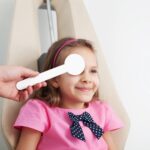
General Facts
Amblyopia is a condition also known as “lazy eye.” It usually begins during early childhood. Children with this condition do not develop normal sight in one or both eyes. Treatment for amblyopia should begin as soon as possible. If left untreated, amblyopia can cause permanent visual impairment. What is amblyopia? Your vision rapidly changes during early childhood. To have normal vision, both eyes must develop at the same pace. Children with amblyopia have compromised vision in at least one eye. The brain favors the eye with normal vision and the weak eye tends to wander. Eventually, the brain may completely ignore signals sent from the amblyopic eye. If not treated early, children can develop permanent visual defects and loss of depth perception.
Causes
What causes amblyopia ? Amblyopia can result from any condition that affects visual development during childhood. There are three main causes of amblyopia: Strabismus. The most common reason for amblyopia is strabismus, or misaligned eyes. The brain ignores signals from the misaligned eye to prevent double vision. As a result, the child doesn’t develop normal vision in the amblyopic eye. Refractive errors. The child is nearsighted or farsighted in one eye. The brain ignores signals from the eye with poor vision. This can be more difficult to detect, since the child has a normal appearance. Clouding or obstruction. Cataracts, trauma, and scarring can lead to amblyopia. Since the child cannot see clearly in one eye, the brain ignores the signals it receives. This is usually the most severe form of amblyopia.
Symptoms
What are the symptoms of amblyopia ? Amblyopia can be difficult to diagnose. Children may not be able to recognize or verbalize problems with their vision. The symptoms of amblyopia in children can include : Poor vision in one or both eyes, A wandering eye, Poor visual acuity, Squinting, tilting the head, or covering one eye to see clearly, Poor depth and contrast perception, Headaches.
Diagnostic
How is amblyopia diagnosed ? An ophthalmologist can detect amblyopia with a vision test. If your child is very young, your doctor may use a visual acuity test to see how well your child follows a moving object with one covered eye. When the strong eye is covered, your child may attempt to remove the patch or cry in frustration. An ophthalmologist can evaluate your child and make an accurate diagnosis.
Treatment
How is amblyopia treated ? If your child has amblyopia due to refractive errors, your ophthalmologist will prescribe eyeglasses. In most cases, treating the root cause doesn’t completely correct the problem. It’s likely that your child will need an eye patch to develop normal vision in both eyes. After covering the strong eye, the child can develop normal sight in the weaker eye.You may also use special blurring eye drops or glasses to block normal vision in the stronger eye. You may need to cover or blur your child’s strong eye for weeks for months to strengthen the weak eye. The strong eye may need to be covered on a part-time basis until your child is at least 9 years old. Your child may also need surgery to correct misaligned eyes. After your child has recovered from surgery, your ophthalmologist can treat the amblyopia. If your child has amblyopia due to cataracts or other problems, the first step is surgical correction. Afterwards, your ophthalmologist will treat your child for amblyopia. Early surgical correction is essential for normal vision. The outcome depends on early treatment and the severity of the condition. When treated early, most children can improve their vision. A licensed ophthalmologist can help you develop a treatment plan for your child.